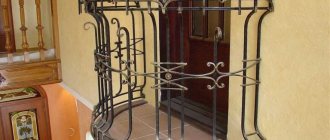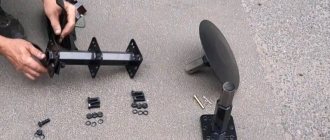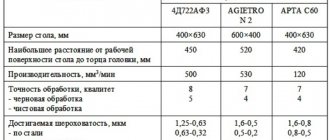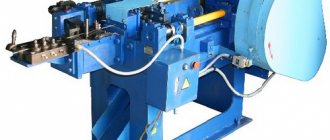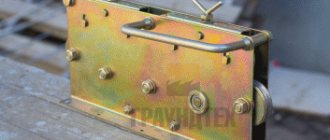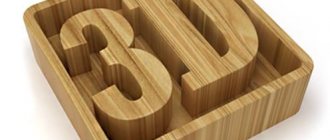The central part of the machine is a cast planing table, which is mounted on a stable tripod. Thanks to this design, vibration is eliminated. The planing table also includes a bottom cutter and 2 side cutters. The upper cutter and rollers are fixed on a tripod. They move along massive rods. 4 cutters are powered by separate motors.
Design and scope
Relatively recently, designs that combine several operations have appeared in the wood processing industry. Processing of wooden products occurs on four sides at once. This equipment is most often used for milling and jointing.
The woodworking machine consists of:
- spindle section;
- part feed unit;
- equipment parameter control systems.
On one side there can be several processing heads, which reduces the cost of manufactured products and reduces the time for performing a certain operation.
The four-sided machine is designed to perform the following operations:
- Milling. Instead of planing shafts, disk cutters are installed on the working heads of the equipment, which makes it possible to do longitudinal milling. To carry out processing with finger cutters, it is necessary to periodically stop the parts, however, this is not provided for by the design;
- Planing and jointing. This can be done using shafts with blades of a certain configuration installed on them. The design of the machine makes it possible to simultaneously perform finishing and roughing;
- Reaming and profiling.
Most often, such models are used to create lumber with a flat surface or profile. All the work can be done in one pass.
Using four-sided machines you can make products such as:
- parquet or floorboard;
- profiled or laminated timber;
- lining;
- baseboard;
- imitation timber;
- window and molding elements.
Design features and purpose
Before you start making a four-sided machine at home, you will need to familiarize yourself with the design features of a typical planing unit.
The classic design of a 4-sided woodworking machine can be represented as a combination of the following main parts:
- mechanism for receiving and feeding workpieces;
- a typesetting section consisting of a spindle with a cutting tool (mill or knife saw);
- engine (gasoline or electric) with drive;
- organs for setting cutting parameters, adjusting, feeding and controlling the entire process.
Four-sided models are known, which have several spindles with cutting tools arranged in one row.
According to the features of their application, all known designs of machines for profiling boards and making timber are divided into two large groups, within each of which many intermediate options are possible.
Firstly, this is a portable (mobile) machine for profiling timber, which can be assembled with your own hands and is widely used at home or in workshops with small production volumes. Its main advantage is mobility (the ability to move to the place of work), as well as good adaptation to any processing conditions. The disadvantages of such a 4-sided unit include the impossibility of expanding the range of products and low automation.
Secondly, this is a universal stationary woodworking machine that provides significant volumes of lumber. Stationary machines are usually equipped with CNC systems and a whole set of interchangeable cutting tools.
The four-sided stationary machine is designed to perform a range of woodworking operations, including routing (in this way it is similar to a milling tool), planing and jointing, as well as thicknessing and profiling. With their help, it is possible to process a wide variety of types of wood raw materials and obtain finished products of various names and sizes (timber, lamellas, slats and lining).
Feeder
The feeding device of a modern four-sided machine with a planing function can be represented as follows.
The supply of wood blanks (future timber) is carried out by means of four drive rollers, and a set of upper and side clamps is responsible for its correct orientation in the direction of movement. The rollers located on top perform their function due to their own weight or under the influence of spring amplifiers.
Note! Adjustment of the size of the removed chips and profiling of the workpieces is carried out by moving the front part of the table vertically.
Wood lumber is fed into the device in a continuous mode, in which there is no gap between successive pieces one after another.
The latter is explained by the fact that even a slight gap in the feed will require new filling into the rollers, which significantly reduces the productivity of the equipment and increases labor costs.
It is possible to increase the productivity of the entire four-sided woodworking machine as a whole by partially automating the receiving unit, carried out by combining the functions of positioning the board and its feeding. It is usually set at a speed of about 8-22 meters per minute, but in some modern equipment this parameter is increased almost five times.
The number of revolutions of the cutting tool per minute averages 5-6 thousand units (in the latest models of the latest design it has been increased to 9 thousand).
Processing area and unit
A typical processing unit of a four-sided woodworking machine contains upper and lower horizontally mounted shafts and a pair of spindles mounted vertically. Each of them has a cutting head equipped with a straight or shaped knife. The size of the workpiece is set by horizontal movement of the spindle (changing the position of the cutting edge). When cutting boards, their thickness is set by the vertical movement of the upper shaft.
The processing unit kit may include an additional (fifth) cutting or planing shaft, which ensures the arrangement of a profile along the lower edge of the workpiece. To eliminate the effect of waves formed on the surface of the wood from the circulating heads, special knives are provided in this area. They provide an imitation of smoothing. The knives are made in the form of a block of blades fixed on the base of the table, attached at an angle of 45 degrees to the feed plane and cutting off about 0.02-0.2 millimeters of wood from the surface being processed. Thanks to this arrangement of the unit, the wave crests remaining from the operation of the jointer are completely cut off.
Control system
The operation of four-sided stationary woodworking equipment is usually controlled from a remote control panel, but such a system is not suitable for a homemade device.
Note! In the case of self-manufacturing of the machine, the main thing is to provide mechanisms for setting the size of the workpieces and the speed of their feeding into the cutting zone.
In addition, it is necessary to provide the ability to set the position of the set of spindles relative to the part, as well as vary the type and diameter of the cutting tool. One should not lose sight of the mandatory presence on the woodworking machine of functional elements responsible for turning it off and on.
Classification and differences of machines
All four-sided woodworking machines can be divided into:
- thicknesser planer;
- longitudinal milling.
A longitudinal milling machine is used to cut material along the length to the desired size. This woodworking equipment can perform profiling of any complexity. The lower shaft of the knife, taking into account the thickness of the wood being planed, moves together with the tabletop in the vertical direction.
A thicknesser is used to plan a part to a specified thickness on both sides simultaneously. It is initially planing, but has an additional profiling function. Such a device can produce shallow profiling with a simple locking design of a small beam.
Processing wood on four sides simultaneously helps save time, increasing production productivity. That is why four-sided machines are the optimal equipment in the construction and furniture sectors.
Main criteria for selection
Considering that a machine for complex woodworking is expensive equipment, when choosing it it is important to take into account the technical characteristics and all the nuances of the design. Equipment performance depends on:
- speeds and timber feeding systems;
- degree of processing and dimensions.
When choosing the optimal machine model , you should pay attention to:
- workpiece feeding system. It is represented by a set of shafts with a corrugated surface. To minimize the occurrence of defects, system elements must be rubber-coated;
- bed design. Due to the fact that most often such equipment is intended for processing massive products, the frame must withstand maximum loads. The best option would be to choose cast iron;
- accuracy of the operation;
- the complexity of setting up the processing unit. CNC models handle this task best. Milling cutters and planing knives are adjusted automatically. To do this, the machine must be programmed.
In order to accurately position the workpieces relative to the machining center, a sensor system is required. In addition, when analyzing the model, you should take into account the cost of components, the degree of remoteness of the manufacturer’s service centers and warranty conditions.
Components and functionality
The main functions that a four-sided planer can perform are jointing, milling and planing. Thanks to the special design of the machine, finishing and roughing can be performed simultaneously.
The main components of the model are:
- workpiece feed unit;
- spindle section;
- Control block.
In this case, there can be several processing heads. Thanks to this approach to layout, operating time is optimized and the cost of finished products is reduced.
Before you start working on a four-sided machine, you need to understand how certain settings affect the device. Be sure to pay attention to how performance changes after tuning the processing units.
Design of machine components
To understand the operating principle of the equipment, it is necessary to consider the design features of the machine , which includes many components.
- The basis of the machine is a cast iron bed, which can have a different alloy and inserts. During equipment operation, it must absorb a certain amount of vibration and, thanks to its large mass, reduce it to zero. The material of the loading table is important for feeding timber. For more convenient work, it may contain auxiliary elements such as a ruler and pressure rollers.
- In a woodworking machine, the number of spindles can be from 4 to 8 or more. Taking into account the model, they are all installed in different working units with independent electric motors. The spindles are fixed in cantilevers. Their number depends on the thickness of the wood removed and the complexity of the profile.
- The four-sided longitudinal milling machine has working rollers. The main ones are rollers with a spindle, located vertically on the right and horizontally on the bottom. The number of planing and shaping elements affects the power, equipment class and performance of the model. The model range of different machine tool manufacturers has universal equipment with the presence of an element that replaces any horizontal or vertical spindle. It can be used as an inclined roller and process the product at an angle.
- Feeding device. Feeding, broaching and unloading of products in a woodworking machine are driven. The work is done using toothed and rubberized pressure rollers. This system is controlled from a remote control, but the price for such a computerized device is much higher.
- Control and security system. During timber processing, the protective cover reduces noise and protects the operator from injury. Additionally, the sight glass can be equipped with illumination. The four-sided woodworking machine is controlled from the panel. You can set the dimensions of the timber and the feed speed of the product to the tool. In addition, the position of the spindles relative to the nozzle part and diameter is set, turning it off and on.
Some equipment models include a joyter, a hydraulic spindle and a number of working tools. Such devices sharpen knives directly during product processing.
Homemade machine (option for beam profiling)
A four-sided profiling machine must include such mandatory elements as a base (bed), a drum with a set of knives and an electric or gasoline engine. In addition, it should be equipped with a movable frame, which has the ability to adjust the size of the workpiece according to the processing height, as well as special fixing and locking elements.
When manufacturing a device for profiling workpieces with dimensions 150 x 150, it is necessary to select a sufficiently powerful engine with suitable characteristics. For the stated purposes, a Honda gasoline unit with a capacity of 6.5 horsepower, developing up to 3600 rpm, is quite suitable.
After selecting the engine, you should prepare a set of metal plates, angles and channels and weld from them according to a previously drawn up sketch a frame structure on which the selected unit must be securely fastened.
From the motor shaft, the rotating moment is transmitted to the knife drum through a pulley system. All these parts can be removed from old non-working machines or ordered from a workshop, having previously prepared their drawings.
The movable frame must move along specially prepared guides with rollers built into them (they are attached to the corners of the structure). In total, it is necessary to provide four rollers fixed from the bottom of it.
Feeding of processed workpieces is carried out manually in a home-made device (due to the muscular strength of the operator). To change the height and depth of processing within 5-10 cm, the engine with the knife drum must move freely vertically to the limit stops.
It should be noted that before manufacturing a woodworking machine with four-sided processing, it is necessary to carefully study the theoretical material and practical implementation options. Only under this condition will it be possible to produce a reliable working structure that guarantees the solution to the task assigned to the user.
A four-sided longitudinal milling machine for wood is designed for planar and profile simultaneous milling of boards, beams and workpieces of various types (this tool is popularly called a “four-sided machine”; we will not deviate from tradition). This tool has its own features and characteristics, which we will talk about...
The most common quadrilateral models are S26-2M, S25-2A, S25, S16-2A. The C16-2A type machine is used to work with cabinets, baseboards, joinery and similar materials. The first three machines process flooring (boards), as well as beams for window and door frames.
Table of contents
Setting up a four-sided machine
A four-sided woodworking machine is a cast-iron frame on which there is a table, cutting and feeding mechanisms that drive an electric motor.
Before starting work, you must install a sharp knife or cutter. After this, based on the part itself, the machine is set up (rulers, clamps, feed mechanism, etc.). The clamping mechanism must be installed so that the bar passes as freely as possible and does not vibrate. The upper rollers are installed so that the block can pass under them when they are lowered down.
After making sure that the machine is set up, you need to run a few test bars through it. Thanks to this, you will definitely be sure that the machine is configured correctly, and even if this is not the case, you will not spoil the desired workpiece. Workpieces must be fed end to end. First process short workpieces in multiples of length, after which you can begin trimming.
Main problems and their elimination:
- Uneven surface. The defect is possible due to improper adjustment of the knife shafts and/or vibration of the machine;
- Grabs on the sides. This defect indicates incorrect adjustment of the clamps, or processing of curved workpieces;
— Distorted profile – incorrect installation of knives/cutters on vertical heads;
— Inconsistency between groove and tongue. This defect is formed due to inaccurate installation or sharpening of cutters.
Two basic safety rules - do not work on the machine without a guard, do not climb into the machine while it is working (cleaning, adjusting, etc.).
Types of cutters, or how and with what to work...
Before installation, knives and cutters must be perfectly sharpened and well balanced. Attach to the shaft evenly, tighten the bolts one by one, starting from the center.
There are four types of cutters - shell and end, solid and composite. To work with carpentry parts, attachment and compound cutters are usually used. When adjusting the cutters, the parameters are saved, and at the end of sharpening the profile does not change. The diameter of the cutters is 80-180mm.
To achieve smooth milling, use cylindrical attachment cutters with a diameter of 80-140mm, height - 40-260mm, with four insert knives.
For ideal production of grooves and ridges, use mounted backed cutters. This type of cutter is used to select grooves 4-12 in width in boards with a thickness of 28 and 36 mm.
Brazed insert disc and slot cutters are ideal for:
— Rectangular longitudinal and transverse grooves;
The cutters are complemented with plates made of high-speed steel or carbide.
For smooth milling, cutters that have from 4 to 8 cutters are usually used. The advantages of cutters over knives are quick and easy installation, an increased level of safety (unlike knives).
Operation of a four-sided longitudinal milling machine
Lubrication
— It is necessary to lubricate the machine gearbox gears every quarter (that is, every 3 months) with AK-Yu oil;
— Ball bearings are lubricated with US-2 grease at the same frequency;
— Bushings and plain bearings - every shift with solid oil US-3;
— The set screws are lubricated with US-2 grease every month;
— Lubricate the caliper guides with IM-45 every month.
Setting up a four-sided machine
When setting up the machine to the required material thickness, the support with the upper rollers, as well as the support at the top of the cutter head, must be adjusted in height using flywheels, and the pressure rollers - using screws. To adjust the width, use the left vertical spindle and side clamps.
Adjustment to the required profile is carried out by installing profile knives on the heads.
Basic rules for setting up a four-sided machine:
— Set the edge of the front table and the lower rollers below the table to a thickness equal to the layer of wood being removed;
— The upper rollers are set according to the thickness of the workpiece (clamp margin – 5mm);
— The knives of the front head are installed at the level of the rear table;
— The upper rollers and pressure rollers adjust the width and thickness of the workpiece. In the rollers, the clamping margin is 5 mm, in the clamping ones – 15-20mm;
— The guide stop ruler is installed at a distance of 3-4 mm from the vertical head (maintain an angle of 90 with respect to the lower rollers);
— We carry out the final alignment of the cutter heads.
What the machine should provide after adjustment:
— straightness of the side edges (check with a feeler gauge, the permissible norm is 0.2 per meter);
— parallelism of opposite edges (check with a caliper, acceptable norm is 0.3);
— perpendicularity of adjacent edges (check with a feeler gauge, tolerance 0.15 to 0.1 m);
— uniform thickness of the bar.
DIY four-sided machine
A high-quality four-sided beam machine, which will give the owner pleasure in use and will bring a minimum of hassle, is quite expensive. A significant portion of people prefer to make a homemade four-sided machine. You don't have to be a super professional to make a four-sided machine with your own hands. So, let's take a closer look at what stages the manufacturing of a machine consists of.
Instructions
- First of all, we create the frame for the machine itself. This is the surface on which all the necessary equipment will be installed. The frame must have a U-shaped elbow that will hold the Z axis. For this, a 2.5 cm thick pipe is required. Once the pipe joints are in place, use sealant.
- Motor and X-axis guides. Now we need to install the X-axis guides. They are made of aluminum, and should have a U-shaped recess 1.9 cm wide. You can buy them at any store that sells metal products. We install the motor with the holder and attach it to the electric motor shaft.
- We are preparing the base (X axis), we need metal or plastic that will be attached to the frame. Then we attach the bearings to a piece of aluminum.
- We are preparing platform Y. It is identical to platform X, only rotated 90 degrees. Next comes the installation of the motor and guides on the X platform, after which the moving platform Y is assembled. Don't forget about the coupling nut and bearing.
- Assembling the Z axis. At this stage of assembling the Z axis, you should repeat the procedure for assembling the X and Y axis. We take a flat material and attach the motor with guides to it, after which we install the bearing and the U-shaped profile. Our platform moves up and down, so the weight of the engine can cause it to jump off. To prevent this, install a roller bearing at each end of the guide.
The final stage. Attach your engine to the Z platform and install the platform into the frame. Our design is almost ready. All we have to do is connect the electric motors and run the program.
We bring to your attention “How to assemble a four-sided machine” video.
Machines from reputable suppliers – quality guarantee
"DIOS" - woodworking equipment and components
The trade and industrial group "Marketlis-DIOS" has been providing customers with high-quality woodworking equipment from well-known global manufacturers for more than 17 years. Since 2002, this company has been operating as a separate structure, and has more than successfully supplied Ukrainian manufacturers with high-quality and necessary equipment: woodworking machines, woodworking equipment and tools, etc.
The company annually takes part in world thematic exhibitions. Knowledge of the latest innovations and achievements in its field, as well as many years of experience, allow the company to compete with well-known European suppliers.
LLC "Trading House Negotsiant-engineering"
LLC "Trading House Negotsiant-Engineering" began its existence in the woodworking market in 1997. Today this company is one of the leaders in the supply of European woodworking equipment to the Russian market.
Among the customers of Trading House LLC are well-known Belarusian and Russian companies and furniture factories, with which we have established trusting relationships. "Trading House Negotsiant-Engineering" is a dealer of more than one hundred European and Russian equipment manufacturers.
The company not only supplies equipment, but also provides consultation, offers final technical solutions, and also offers installation, commissioning and maintenance services for equipment.
Global Edge Group of Companies
The expression "Global Edge" appeared in 1991. This is perhaps the most famous group of companies on the Russian market. Global Edge are pioneers who were the first to bring high-quality woodworking equipment to Russia in the 90s.
Band sawing machines, American four-sided machines, European equipment for mass production of furniture and other equipment are all the credit of Global Edge.
The company has many serious awards, including: the all-Russian competition “Russian Forest”, “Leader of Wood Processing”, “Best Russian Enterprises”, “Best Supplier 2005”, “European Standard”, in all these competitions the company took first place.
Four sided milling machine price
We have already looked at how to make a machine with your own hands. However, if you have the opportunity to buy a ready-made machine, it is better to choose this option. The price for a four-sided machine is quite varied, and is in the price range - 400,000-1,000,000 rubles. The price of knives for a four-sided machine starts from 220 rubles. You can buy a used one, or a Chinese-made machine - but the effect is not at all the same. The two best options are to buy or make it yourself.
Purchase of a machine
A longitudinal milling machine can be purchased at specialized construction stores, but it is better to buy it directly from the manufacturer (if we are talking about domestic manufacturers). You can rent equipment or purchase it in installments.
Before purchasing equipment, you need to pay attention to the following main points:
- performance;
- accuracy;
- reliability of operation;
- availability of service;
- equipment price.
If a four-sided wood saw will be an addition to an existing line, it is important to consider its dimensions. During the purchase, it is necessary to take into account the technical parameters and the combination of various processing options, the weight of the equipment and the speed of work.
Some companies providing such equipment are still little known. The price of their products is relatively low, and the quality is adequate . For example, the German brand Beaver. The cost of their products is low due to the fact that production is located in Taiwan and China. But parts of the assembly are made in Germany.
When choosing equipment, you should not consider cheap Chinese-made models. Please note that it will be very difficult to find spare parts for them.
Features of work
When using a four-sided wood saw, you must follow the rules specified in the instructions. Parts cannot be processed if their length or thickness exceeds those required by the rules. It is necessary to carry out preventive maintenance in a timely manner to maintain the normal condition of the machine.
The work will have maximum efficiency only if the following operating rules are followed:
Calculate in advance the speed at which the workpiece must move. If this condition is not met, then maximum accuracy cannot be achieved.- Separately deal with the regulation of each block: separately monitor both the milling and planing processes. It should be remembered that the work of these two blocks must be coordinated, otherwise the part will not acquire the desired shape.
- All waste that appears at the work site, especially those generated in the processing area, must be removed in a timely manner.
Service maintenance
Any machine tends to break down over time and its component parts wear out. To ensure fewer interruptions in work for such reasons, it is advisable to choose the most durable and wear-resistant .
In addition to productivity, it is important that the machine is as safe as possible. Therefore, the presence of limit switches, electric brakes and a metal protective casing with sound insulation is provided.
Processing of products on a machine must be as accurate and high quality as possible. For these purposes, it is important that the device has statistical and dynamic balancing of all fixations of parts.
When operating the equipment, you must adhere to the rules specified in the instructions for it. You cannot process workpieces that are larger in size than those provided for by the rules. It is imperative to carry out preventative and repair work to keep the equipment in working condition.
It is very important to install the machine correctly , taking into account not only its dimensions and weight, but also the size of the wooden blanks. The operator should not have to deal with any difficulties associated with feeding the material.
Design of thickness planer
The design of the thicknesser consists of a motor with a knife shaft attached to it, there is also an adjacent working surface and special rollers.
Thicknessing machines are used for processing wooden elements and manufacturing products on an industrial scale. Some types of such equipment can also be used for domestic purposes.
Different machines have certain design features , differ in the power of the functioning equipment and the specifics of the work performed. The maximum shaft rotation speed may also differ between thicknesser models. The dimensions of the machine, the depth of the cut made with its help, and the width of the cut also differ for machines of different types and sizes, depending on their functionality.
The equivalent cost of machines of one type or another also differs from each other: more powerful models, which have the widest range of tasks to be solved and methods of processing parts, as well as larger machines, cost much more than small, cheaper budget mechanisms for wood processing.
Operation
Typically, processing materials using a thicknesser involves planing wooden blanks and parts that are slightly longer in length than the length of the distance established between the rollers.
A thicknesser works using a flat planing method that processes the material. In this case, the processing of a wooden workpiece is carried out due to the work of the following elements:
- Knife shaft. The knife shaft included in the design of the thicknesser performs the main function when processing the workpiece.
- Rollers. The parts are fed to the surface of the work table under the action of installed rollers.
The part is fixed on the working surface using a special mechanism, which ensures the most accurate processing. After this, the part is planed using knife blades acting on it from above.
This is how the parts are calibrated to the required size , which makes it possible to make them absolutely identical in size and give them the same shape. If the thicknesser has an automatic feed mechanism, then the speed required for drawing parts can be adjusted.
When used during processing of special overlay parts with the help of such a machine, it is possible to plan materials that have oppositely located non-parallel edges. In this case, it is necessary to install the parts, giving them a certain angle of inclination.
Carrying out work on processing parts using such equipment provides the opportunity to obtain the highest quality . In addition, by processing lumber on a surface planer, you can perform the job in the most accurate manner, regardless of the total number of parts used.
Thicknessers are very economical woodworking equipment in terms of maintenance, which is characterized by a high level of productivity.
The operating mechanism used allows processing lumber up to one meter wide and a little more. In this case, the greatest depth of the cut produced is usually 145-155 mm and even more, depending on the model used.
Pros and cons of equipment
One of the most positive qualities of four-sided machines is their high productivity. To achieve optimal results, the design must be equipped with a software numerical control unit. Then the influence of the human factor will be minimal.
The conditions for the correct preparation of the program must be met, and the workpiece being processed must be accurately measured. In its optimal configuration, the equipment is designed for processing cylindrical workpieces and rectangular beams. Jointing and milling of sheet materials can be performed on both sides. Features of the operation of machines of this type are the following factors:
- the speed of movement along the workpiece bed is calculated in advance to ensure maximum processing accuracy;
- each jointing and milling unit is regulated separately, their functioning with each other must be consistent;
- waste is promptly removed from the treatment area.
The main disadvantages of woodworking four-sided machines are the high cost and complexity of setup. However, in production line conditions these indicators are not significant.

